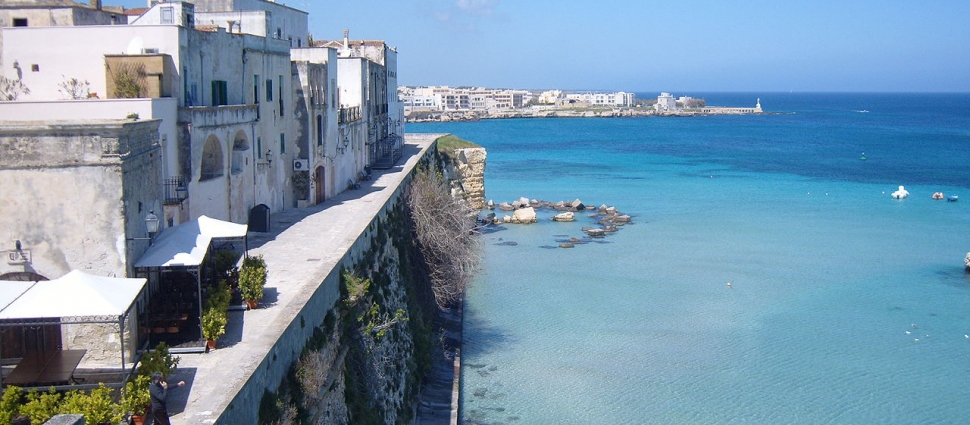The Otranto Martyrs

On July 28, 1480, citizens of Otranto, Italy, spied a large Turkish fleet approaching their coasts. Otranto, an amiable town around the tip of the heel of the Italian “boot,” had long been an important port. Ita strategic position, however, also made it susceptible to attacks from across the Adriatic Sea – particularly from Turkish raiders who often scoured the coasts of Italy.
By that time, the Ottoman (Turkish) Empire had become very powerful. Less than thirty years earlier, in 1453, its troops had taken over Constantinople, putting the final nail to the coffin of the Roman Empire that had survived in the East. Proud of his achievements, Sultan Mehmed II entertained dreams of expanding to the west.
Most likely, Gedik Ahmet Pasha, leader of the Turkish fleet that was moving in the direction of Otranto, shared his sultan’s dream. Its fleet was impressive: 150 ships carrying 18,000 soldiers. This was not meant to be a simple raid.
Apparently, he had planned to attack Brindisi, a more important port further up the coast, but had been forced (possibly by strong winds) to change route.
Given their large army, the Turks must have thought that taking Otranto would have been a simple feat. The pasha sent a messenger to ask the people to surrender, but the people’s answer was a firm no. He then sent a second messenger, and this time the people killed him before he even entered the city.
This would have been an unforgivable offense in any diplomatic negotiation. What followed was a two-week siege where the local population fought earnestly with few trained soldiers and limited weapons. Eventually, the besieged were forced to surrender. The Ottoman soldiers then took over the city, destroying the local castle, raiding every home, raping women, and killing men.
Not all Muslims demanded the conversion to Islam of the people they conquered. Most of them allowed Christians or Jews (“People of the Book”) to continue to profess their religion, as long as they entered into a contract (dhimma), acknowledging their status and obligation as subjects, and paid a tax called jiziya. In time, however, many conquered people converted to Islam for a variety of reasons, just like many pagans became Christian when Constantine made Christianity a preferred religion.
In this case, however, according to reputable contemporary writer, Antonio De Ferraris (better known as Galateo), Gedik Ahmed Pasha didn’t give the people a third choice. It was conversion or death – possibly because of the murder of the Turkish ambassador.
Many citizens of Otranto were able to barricade themselves inside the local cathedral, where their bishop, Stefano Agricoli, led them in prayer. But the Turks soon conquered the church, captured and enslaved women and children, and led the 813 men over 15 years of age to a hill known as Colle della Minerva (Minerva’s Hill) to be beheaded. It was August 14, 1480.
A weaver named Antonio Pezzulla, who more than others had exhorted everyone to stay firm in their faith, was executed first. A traditional account reports that his beheaded body continued to stand until the end of the execution. The bishop’s head was paraded around the town on a pike. Still according to tradition, one of the executioners, Berlabei, moved by what he saw, threw his sword to the ground and converted to Christianity, thus becoming one of the victims.
Galateo, who was also a physician, philosopher, and astronomer, continued his account by affirming the faithfulness of the people. “No one, in such a large number of people, recanted their faith in Christ for fear of death. In fact, they all encouraged each other to die.”[1]
Eventually, Ferdinand of Aragon, king of Naples, knowing that the pasha meant to conquer his territories, sent his forces, led by his son Alfonso, to repel the Ottoman troops. The struggle ended when Pasha died and his sons began to argue about their role as successors.
Today, a monument by sculptor Ruffano Antonio Bortone stands on the Otranto seafront, portraying a woman who proudly looks to the sea with a cross in one hand and a flag in the other. The engraving reads, “To the heroes and martyrs of 1480 Otranto, from a grateful Italy – 1923.”
But a walk into a chapel of the Church of Santa Maria dei Martiri, built on the same hill where the 813 martyrs were killed, reveals another monument, more impressive because of its stark materiality: three large glass cases exhibiting the skulls and bones of many of the martyrs, placed so that the skulls are facing the viewers.
In his report, Galateo called the resistance of the people of Otranto “a glorious, uncommon act, worthy of ancient times, which will perhaps be scarcely believed in the future.”[2]
His prediction might have come true, if the bones and skulls of the Otranto martyrs did not stand as a vivid (and uncomfortable) reminder of the reality of this story and martyrdom in general.
Image By Freddyballo - Own work, transferred from it.wikipedia. Original upload date: 7 April 2008, CC BY-SA 3.0, https://commons.wikimedia.org/w/index.php?curid=3919221
[1] De Ferraris, Antonio, quoted in Lucia Gualdo Rosa, Isabella Nuovo, Domenico Defilippis, Gli umanisti e la guerra otrantina: testi dei secoli XV e XVI, Bari, Edizioni Dedalo, 1982, p. 237 (my translation).
[2] Ibid.





